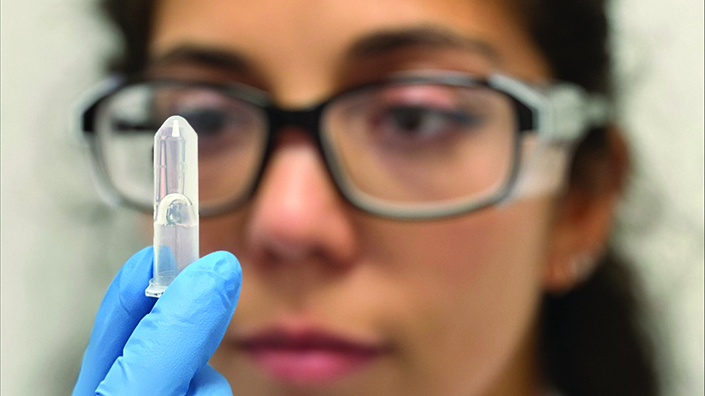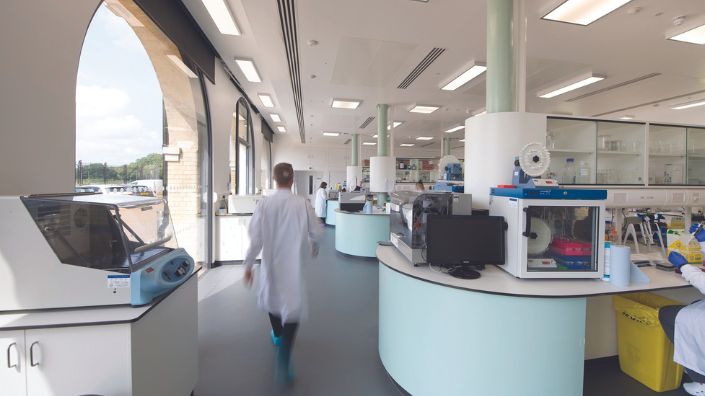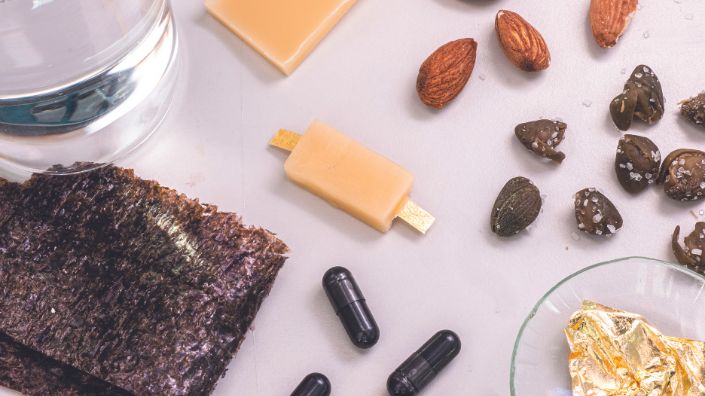Produced by Touchlight Genetics in Hampton, west London, the DNA contained within the ice will weigh just over one gram. Stretched out end to end it would extend 312,800,000km – enough to reach to the Sun and back.
It will be transferred to the University of Utah as part of a project to build DNA-based batteries. By using the building blocks of life on Earth, the partners – including the UK Defence Science and Technology Laboratory (DSTL) and the US Office of Naval Research Global (ONRG) – hope to create a sustainable, safe and lightweight alternative to lithium-ion and other resource-intensive batteries.
The work is part of a new wave of research exploring alternative methods and materials for storing and delivering energy on demand. Using biological materials, from seaweed and sweat to bacteria, the new devices are known as bio-batteries.
Breaking bonds
In the early 2000s, Shelley Minteer and her colleagues had a realisation. Working at Saint Louis University in Missouri, they were exploring the use of biocatalysts such as enzymes and microbes as sensors. They started to realise that a lot of the materials they were developing for detection had potential applications in energy conversion, which kickstarted ongoing work into bio-batteries and fuel cells, including topics such as harvesting energy from waste and the environment.
Now at the University of Utah, the professor of chemistry defines bio-batteries as any batteries of biological origin, unlike the typical lithium-ion or chemical batteries that we use.
As electrification accelerates, we expect more and more energy from our batteries, says Minteer – we want electric vehicles (EVs) that can drive further and mobile phones that last longer. This is driving her research into storing energy in chemical bonds, which she says can contain a lot more energy than redox states found in traditional metal batteries.
Building and breaking bonds is a promising route to explore. “But we don’t have really good catalysts to do that, in terms of traditional sorts of things like platinum, ruthenium, etc,” she says.
“However, if you think about it, biology does this. Photosynthesis takes carbon dioxide from the air and it builds carbon-carbon bonds. We then consume that plant material that was produced, and we have the metabolic pathways within us to break those chemical bonds, to have the energy to do everything that we do…
“But biology does it not by having a single material – say a single platinum electrode – but instead by having a cascade. So we have metabolic pathways or photosynthetic pathways, where it’s a series of catalysts. The challenge, then, is to get those series of catalysts on an electrode surface in very close proximity.”
One potential solution? DNA hydrogels.

DNA hydrogel sticks to the bottom of an inverted tube
Biological polymer
In an old water pumping station on the north bank of the river Thames, Touchlight claims to have the largest DNA production facility in the world. In the converted Victorian buildings, it uses a proprietary enzyme-based production process and benchtop equipment to manufacture multiple grams of DNA in as little as five days.
By gradually refining the manufacturing process since 2007, Touchlight has significantly boosted its yield. As production increases, however, the long chains of DNA start meshing together and become “jellified” into DNA hydrogel, says Tom Adie, head of platform discovery. Thankfully, that material could be incredibly useful.
The bio-battery project started in 2017, after Minteer published a paper highlighting the potential application of DNA hydrogels in bio-batteries. Touchlight contacted her through a US-UK collaboration organised by DSTL and ONRG, leading to the ongoing work.
The DNA hydrogel provides a structure that allows Minteer’s team to put multiple different enzyme catalysts into a battery’s electrode surface at “very, very high concentrations,” according to Adie. This allows for efficient energy conversion as lactate is degraded by the enzymes, which release electrons, which are then captured and used as power.
Initial work using Touchlight-designed and produced DNA yielded promising results from Minteer’s research and development laboratories, says Adie. “It worked brilliantly, except that as soon as it started generating energy it drove the DNA straight off the electrode because of the charge.”
They tackled the issue by “functionalising” the second batch with pyrene, a hydrocarbon, which allows the DNA to bind much more strongly with the electrode. That was sent back to Utah and Minteer once again populated it with enzymes, managing to run current from it and use it for multiple cycles.

Touchlight Genetics claims to have the largest DNA production facility in the world
‘A dried-out nothing’
The next stage in the project, due to start after the arrival of the next batch of DNA in Salt Lake City, is scale-up and demonstration.
“We want to generate two things. One of them is an actual physical prototype that people can see, touch, interact with,” says Adie. This will be in the form of a 5V USB power pack, with 500 milliamp hours (mAh) of capacity – lower than most commercially available devices, which typically range from 10,000 to 30,000mAh.
The other aspect they aim to demonstrate is the system’s stability and portability. These qualities could be maximised by using a technique more often found in food production – freeze-drying.
“When you’ve got your electrode, your carbon nanotubes, the DNA and the proteins all stuck together with the fuel, you should be able to dry that down,” says Adie. “It makes it incredibly light. So you’re shipping around, basically, a dried-out nothing, an ephemeral husk of a battery.”
These would then be reconstituted using water, providing power on the go. The low weight should make DNA bio-batteries much more portable than conventional options, making them particularly useful in disaster relief or military applications – a major potential avenue for future products.
Enhanced safety is another potential draw for the military. Soldiers have to carry increasing amounts of electronics in the field, and the lithium-ion batteries supporting them all pose a fire or explosion risk if hit by bullets or shrapnel.
Bio-batteries contain no flammable or explosive materials, so they are unlikely to cause extra damage if hit. They might even continue working, claims the team.
Wearables are another major opportunity. The batteries could be charged up by sweat, or even placed within the body, powering biomedical devices or technology such as ‘smart’ contact lenses. Both wearables and military applications will require lengthy testing and approvals, however, meaning power packs are likely to be the first commercial use for the technology.
Increased sustainability with the biodegradable DNA bio-batteries should make them an appealing alternative to conventional batteries, claims Minteer. Lithium is not the only limited resource – “if you look at critical minerals that go into batteries, there’s also copper connections. We only have so much copper, nickel, cobalt,” she says. “Something that can be grown has a lot of advantages.”
The edible battery
Sustainability is also a key aim for the edible battery project at the Italian Institute of Technology (IIT) in Milan, which uses ingredients that appear more frequently on the dinner plate than in electronics.
Led by Mario Caironi, senior researcher in printed and molecular electronics, the project’s proof-of-concept battery was influenced by the biochemical redox reactions that happen in all living beings.
The other inspiration was ingestible electronics, says Caironi, small pills that are swallowed to gather information from the digestive tract. “You can place a microprocessor, even an LED, a simple camera inside, so you can do many powerful things,” he says.
“These devices of course have some cost in terms of money, but also environmental costs, and they have some risk of retention.” That risk means they need to be used under supervision in hospital, he says, limiting their potential application.
Caironi’s team instead set out to develop something that could power devices that are ingested at home, without metal electrodes and with the possibility of recharging through energy harvesting.
After careful consideration of the few available candidates, the researchers settled on riboflavin (vitamin B2, found in foods including almonds) as the battery anode, and quercetin (a food supplement and compound found in capers and other foods) as the cathode. These are anchored on activated charcoal, which provides a high surface area electrode. The separator is made from nori seaweed, used in sushi, while the electrodes are encapsulated in beeswax. Two food-grade gold contacts (sometimes found on pastries, or even steaks) extend on a cellulose-derived support.
The battery cell operates at 0.65V, which the researchers said is low enough not to create problems in the body. It can provide current of 48μA for 12 minutes, or a lower level for more than an hour, enough to power small electronic devices such as low-power LEDs.

Almonds, seaweed, beeswax and food-grade gold all play important roles in the edible battery (Credit: Italian Institute of Technology)
Tweaking the recipe
Biomedical devices using the edible battery could be used for diagnosis or treatment of gastrointestinal tract diseases, said the researchers. Other applications could include food quality monitoring or edible soft robotics.
No one has ‘eaten’ one yet, however. “First of all, we are focusing on showing that we can create useful functionalities with edible components and materials,” says Caironi. “We want to show in vitro that we can make an ingestible edible pill that does something useful, or has the potential to do something useful.”
Animal testing will be needed before human testing, which will not happen for a few years yet. Before that, the team is doing cytotoxicity tests to ensure they are edible, and simulating mechanical digestion processes to enhance the tests.
The team has also developed an improved battery, says Caironi, by focusing on the architecture. That work – led by PhD student Valerio Galli following earlier work by Ivan Ilic – has doubled the capacity, provided stable performance for two weeks, and powered a device for one month, as well as maintaining stability in the range 0-37ºC.
Charging up
Other bio-battery projects include a sweat-powered ‘tattoo’ developed by Joseph Wang and colleagues at the University of California San Diego, and a photosynthesising bacteria-based bio-battery developed by Seokheun “Sean” Choi at Binghamton University in New York State.
The diverse nature of bio-battery projects means that their success will rely on a multitude of factors. Commercial use will ultimately depend on practical levels of reusability and capacity for the applications they are aimed at.
The DNA battery project in particular has some ambitious aims. Large versions could even be used to power systems on navy vessels, according to the DSTL. “The limit to use would be based on the performance of any DNA battery and how this aligns to the energy/power demands – for example, DNA batteries may be more suitable for trickle feed into sensors, or generating power in austere environments where other options (such as solar) may not be suitable,” said a spokesperson.
In Utah, Shelley Minteer believes the batteries could have widespread application if they approach their potential limits. “They have a theoretical energy density that is an order of magnitude larger than lithium, so you can store a lot more energy,” she says. “If you think about some being able to store 10 times more energy, that means that your cellphone would work for 10 times longer or your car would drive 10 times further.”
Creating an electric structure with long-term stability is the main hurdle at the moment, so that is a significant focus for the project. The partners are also looking at the ability to generate more current by exploring new materials for faster charging and discharging, such as nanostructured materials like carbon nanotubes or graphene, which provide more surface area.
There is no timeframe for the DNA battery to be on the battlefield, with the DSTL saying that deployment depends on funding and demonstrator performance, but Minteer says that a power bank based on the technology could be available in three to five years.
Taking such a radical new approach to storing and providing energy will never be straightforward, but the twin demands of sustainability and an increasing appetite for energy means it could be an appealing option in the near future.
Want the best engineering stories delivered straight to your inbox? The Professional Engineering newsletter gives you vital updates on the most cutting-edge engineering and exciting new job opportunities. To sign up, click here.
Content published by Professional Engineering does not necessarily represent the views of the Institution of Mechanical Engineers.